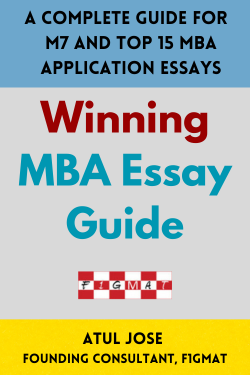A goals and motivation essay framework can help you capture all the right contexts. For the Kellogg MBA, the admissions team has included 5 contexts:
1) Intentionality
Intentionality in a narrative is a style that clearly shows ‘purpose’ in your action.
When events in life are narrated with causality, the reader feels a lack of control. It reads like a log of A happened before B or B happened because of A, but when you add ‘purpose’ to your action, thinking, and goals, the reader feels that events A or B happened because of your action or thinking.
Such addition of intentionality uplifts a narrative from a random applicant building a case for admissions just like the thousands to a protagonist taking the reader through their life’s ups and downs.
Randomness has no value in MBA essays where causality and intentionality rule. So don’t include lucky coincidences or outcomes where an event outside your intentionality impacted an outcome. The only exceptions are world events with a lot of media coverage, like war, financial meltdown, layoffs, or slowdown in an industry.
2) Goals – Short-Term or Long-Term (Motivation)
The goals can be both short-term and long-term. With the word count in the 450 range, you have the opportunity for both. But to truly establish your credentials before building a case for your goals, a milestone capturing your key personality traits must be narrated in 200 words. Ideally, build a strong case for your short-term goal and mention a passion or value that aligns with the potential long-term goals.
For example, if you don’t have any entrepreneurial experience, even at a small scale or activism for renewable energy through investment/consulting, narrating that in 5-10 years, you will start a venture in sustainability is insincere. The admissions team won’t buy your story. Instead of such widely disconnected short-term and long-term goals, capture a passion or a value that connect with your goals.
3) Why Now?
Every school expects some expression of vulnerability to build a case as to Why MBA now.
For 3–5-year experienced applicants, the ‘Why Now’ reasoning should be built with recent research, trends in the industry and career progression.
If an applicant is in a leadership role – managerial or team lead, and Kellogg MBA is an opportunity to pivot functions, the effectiveness of the applicant’s personality in another function (mostly consulting) should be the reason for ‘Why Now.’ I have seen this for applicants from Manufacturing, Oil and Gas, and Technology.
Experience Goals: For an applicant, who already are in a role like the role they are targeting post-MBA, the motivation should be completely different from a traditional industry or function narrative. The experience at Kellogg, preferably through Pathway and global experiential learning should be highlighted.
The Why Now is dependent on your current role.
4) Why Kellogg is a good fit (Curriculum, Culture and Experiences)
With a breakdown of the curriculum in the essay guide, you should have unique values to cite for the ‘Why Kellogg’ MBA context of the essay.
An MBA program is an analytically heavy technical program. It is important that you mention electives, majors, and, in some cases, pathways from Kellogg’s curriculum to share how you will overcome the skill gap.
Kellogg is known for its inclusiveness. A big, missed opportunity I have seen while editing Kellogg MBA essays is that the culture is not highlighted in the Why Kellogg narrative. If you also have advocated for inclusiveness in your career, extracurricular, or volunteering, share why inclusive growth matters.
5) How will you contribute?
Contributions are primarily through student clubs. Mention at least one student club. And when you cite the club, you should be clear about your role.
Top 1%: If are in the top 1% for professional accomplishment, and plan to continue in your industry/function, you may translate that role in the student club.
For a top-performing VC applicant, narrating the necessity to raise funds for one of the most popular Kellogg MBA student clubs was a no-brainer. Her ambitious fund-raising targets for 2030 were believable.
When you try to connect your professional skills with contributions to student clubs, start with a line about your biggest achievement, like,
“As the lead contributor for our $10M fund-raising initiative, I strongly believe that Kellogg’s Y club could have a wider impact on communities in Evanston with a larger fund…”
If you don’t want to make such obvious connections, start the essay with a role in extra-curricular or volunteering that is similar to the role you are mentioning for the club. Then, after the narrative, include your potential role and contributions.
Look at all the student clubs and analyze the gaps. Then put your talents, skills, network and thinking into the mix.
Paint a picture of the potential of the club.
Network: Another meaningful way to contribute is by leveraging your network. If you work in an emerging technology or a region, highlight how you will bring experts/entrepreneurs from the technology/region to the speaker series.
New Student Club: You must build a strong case for a new student club if you feel that a function, cause, demographic, or interest is not currently represented at Kellogg. A random observation about the missing link doesn’t work. Ideally, bring your identity/connection to the underrepresented ‘group’ and share why such a student club is essential for the community.
Instead of just focusing on student clubs and connecting your personal and professional experience with it, you should explore Kellogg’s brand statement.
What Kellogg has Stated
There is no better place to find what a brand/school stands for than reading their mission/vision/purpose.
Kellogg’s purpose is
To educate, equip and inspire brave leaders who build strong organizations and wisely leverage the power of markets to create lasting value.
Building a strong organization requires
a) Fearless leadership with a long-term view
b) Maturity to recognize competitive threats
c) Allocating and utilizing resources to address short-term and long-term strategic goals
To meet the three objectives, the applicant should have
a) Courage to set ambitious goals and make tough decisions for themselves, the team and the organizations they serve
b) The empathy that contributes toward active listening and problem solving
c) Emotional intelligence to motivate the team
d) An impact-oriented mindset that gives long-term value
Value: Courage, Empathy, Impact-Oriented
What does Kellogg Communication/Blog state?
Kellogg clearly positions itself as a school that has championed the cause of women leaders and applicants. ‘Inclusivity’ as a value is essential to reverse an earlier stagnant 30-35% women representation in top MBA programs to consistently featuring among the top 5 schools in the world for women representation.
Value: Inclusivity, Integrity
What do the incoming class and post-MBA job function states about the values that have attracted top Employers?
The 25% from humanities and 50% from Economics/Business – a combined total that is 75% from backgrounds that value cross-functional thinking and extraversion, clearly highlights Kellogg’s history of accepting students who can develop systemized thinking in a complex, uncertain environment instead of finding a template for a repeatable problem that Technologists/Engineers are capable of developing on a whim.
The real-world market requires such cross-functional understanding and open-mindedness to accept variables that could jeopardize initial plans.
Value: Open-Mindedness, Humility
Related Download
 I will teach you how to bring your life stories to essays faster with F1GMAT's essay guides. Download below or subscribe to F1GMAT's Service and work with me - Atul Jose, Author/Editor/Founding Consultant, F1GMAT(16 Years of helping applicants gain admissions to M7 and Top 30 schools)
I will teach you how to bring your life stories to essays faster with F1GMAT's essay guides. Download below or subscribe to F1GMAT's Service and work with me - Atul Jose, Author/Editor/Founding Consultant, F1GMAT(16 Years of helping applicants gain admissions to M7 and Top 30 schools) 